Balbharti Maharashtra State Board Class 10 Science Solutions
Part 2 Chapter 5 Towards Green Energy Notes, Textbook Exercise Important Questions and Answers.
Question 1.
Remake the table taking into account relation between entries in three columns.
Answer:

Question 2.
Which fuel is used in thermal power plant? what are the problems associated with this type of power generation?
Answer:
(1) The fuel used in the thermal power plant is coal. Coal contains chemical energy. Upon burning it releases heat energy. This heat is used for generation of electricity in the thermal power plants.
(2) Problems associated with power 8enerations by thermal power plant:
(a) Air pollution: Due to burning of coal, there is emission of carbon dioxide, carbon monoxide, sulphur dioxide and nitrogen dioxide gases. These are harmful and toxic to health.
(b) Soot particles emitted during combustion can cause severe respiratory problems such as asthma.
Question 3.
Other than thermnl power plant. which power plants use thermal energy for power generation? In what different ways is the thermal energy obtained?
Answer:
(1) The power plant based on natural gas and the nuclear power plants also used thermal energy for the power generation. Apart from these, solar energy is also used to produce heat and thereby create the power.
(2) In nuclear power plant, the energy is released by carrying out fission of nuclei of atoms like Uranium or Plutonium. This energy is used to generate the steam of high temperature and high pressure. The steam rotates the turbine. The kinetic energy in steam drives the turbine and turbine in turn drives the generator.
(3) The combustion of natural gas produces gas, which is used to run the turbine. This gas is under high pressure and high temperature. This is used to produce thermal energy.
(4) In solar thermal power plant, thermal energy is generated with the help of solar radiation. For this reflectors and absorbers are used for concentrating solar radiation and converting it into thermal energy.
Question 4.
Which type/types of power generation involve maximum number of steps of energy conversion? In which power generation is the number minimum?
Answer:
The steps of energy conversion are maximum in the thermal power generation. They are minimum in wind energy generation.
Question 5.
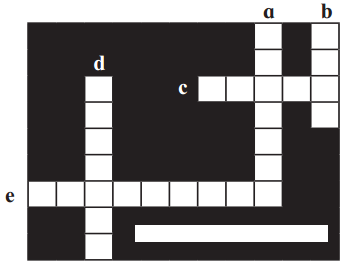
a. Maximum energy generation in India is done using …………… energy.
Answer:
Maximum energy generation in India is done using thermal energy.
b. ………. energy is a renewable source of energy.
Answer:
wind energy is a renewable source of energy.
c.Solar energy can be called ……. energy.
Answer:
Solar energy can be called clean energy.
d. ……. energy of wind is used in wind mills.
Answer:
kinetic energy of wind is used in wind mills.
e. ………. energy of water in darns is used for generation of electricity.
Answer:
Potential energy of water in darns is used for generation of electricity.

Question 6.
Explain the difference.
a. Conventional and Non-conventional Sources of energy.
Answer:
Conventional Sources of energy:
Non-conventional Sources of energy:
b. Thermal electricity generation and Solar thermal electricity generation.
Answer:
Thermal electricity generation:
Solar thermal electricity generation:
Question 7.
What is meant by green energy? Which energy sources can be called green energy sources and why? Give examples.
Answer:
(1) Green energy means eco-friendly form of energy which does not cause environmental problems and are non-exhaustible, perpetual and sustainable.
(2) These sources of energy do not produce toxic gases or other pollutants, therefore they are safe.
(3) Examples of green energy: (i) Hydroelectric energy (ii) Wind energy (iii) Solar energy (iv) Energy obtained biofuels.
Question 8.
Explain the following sentences.
a. Energy obtained from fossil fuels is not green energy.
Answer:
Fossil fuels like petrol, diesel or natural gas when burnt, emit toxic gases and soot particles. Thus, fossil fuels cause air pollution. Burning of fossil fuels cause increased levels of carbon dioxide, carbon monoxide and nitrogen dioxide. The increased carbon dioxide emission results in global warming. Nitrogen oxide results later in acid-rain. Soot particles generated through burning of fuels cause respiratory problems iike asthma.
Moreover, the fossil fuels are non-renewable and exhaustible fuels. They have to be explored from the
deeper layers of the earth causing lots of environmental problems. Green energy is sustainable, renewable and abundant. It never creates any environmental problems and is non-polluting. Thus, energy obtained from fossil fuels is not at all a green energy.
b. Saving energy is the need of the hour.
Answer:
In modern civilization, continuous energy supply is needed for the technology and development. The energy has become a basic need for man. Most of the energy used in India is obtained from thermal power plant. For this energy generation, various fuels are used. The coal and fossil fuels are limited. Due to over-exploitation, these reserves are getting fast depleted. Use of fossil fuels is also resulting in pollution and climate change.
Nuclear energy can be very hazardous. Lot of research is being done in the field of green energy, but the tremendous human population always is in need of more energy. Therefore, each and every person should save the energy, as saving energy is the need of the hour.

Question 9.
Answer the following questions.
a. How can we get the required amount of energy by connecting solar panels?
Answer:
b. What are the advantages and limitations of solar energy?
Answer:
I. Advantages:
II. Limitations:
Question 10.
Explain with diagram step-by-step energy conversion in
a. Thermal power plant.
Answer:
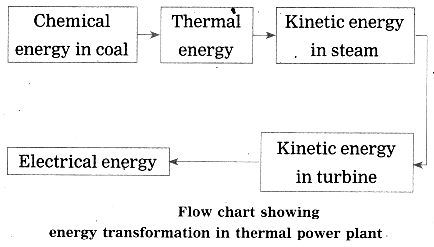
In thermal power plant the turbines are rotated using steam. Here the coal is burnt. The heat energy liberated from this burning is used to heat the water in the boiler. This water produces steam of very high temperature and pressure. The kinetic energy in the steam rotates the turbines. The rotation of turbines produces its own mechanical kinetic energy.
The generators connected to turbines produce electrical energy. The steam is condensed in a condenser and converted back into water. In this way in thermal power plant, thermal energy to kinetic energy, kinetic energy into mechanical energy and mechanical energy to electrical energy, are the conversions that take place.
b. Nuclear power plant.
Answer:
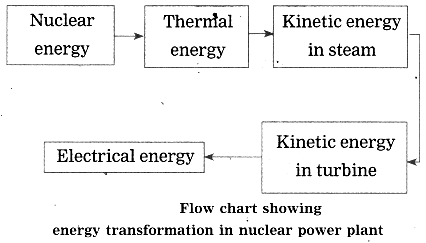
In nuclear power plant, the energy is releasdd by fission of nuclei of atbms like Uranium or Plutonium. This energy is used to generate the steam or high temperature ind high pressure. The kinetic energy in the steam rotates the turbine. The turbine in turn drives the generator to produce electricity.
c. Solar thermal power plant.
Answer:
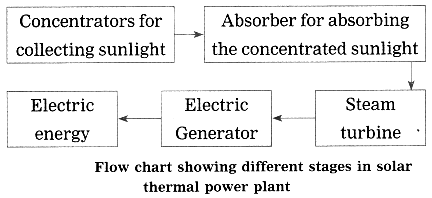
Solar radiation is used to produce thermal energy. For this purpose, many reflectors are used which concentrate the solar radiation on absorbers. The heat energy created due to solar radiations is used to make steam. The steam possesses kinetic energy. This kinetic energy drives turbine and generator. The electrical energy is thus created from this kinetic energy.
d. Hydroelectric power plant:
Answer:
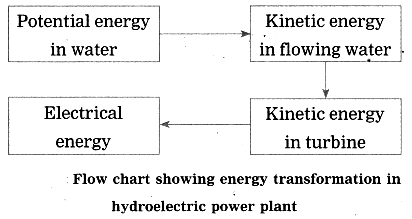
In hydroelectric plant the water stored in the reservoir is used as a source or potential energy. This water is made to fall at a great speed and hence there is production of kinetic energy in flowing water. This fast flowing water ralling down from the reservoir is brought to the turbine at the lower levels. The kinetic energy of the flowing water in turn drives the turbine, The turbine then drives the generator and electrical energy is produced.

Question 11.
Give scientific reasons:
a. The construction of turbine is different for different types of power plants.
Answer:
b. It is absolutely necessary to control the fission reaction in nuclear power plants.
Answer:
c. Hydroelectric energy, solar energy and wind energy are called renewable energies. (July ’19, Board’s Model Activity Sheet)
Answer:
d. It is possible to produce energy from mW to MW using solar photovoltaic cells.
Answer:
Question 12.
Draw a Schematic diagram of Solar thermal electric energy generation.
Answer:
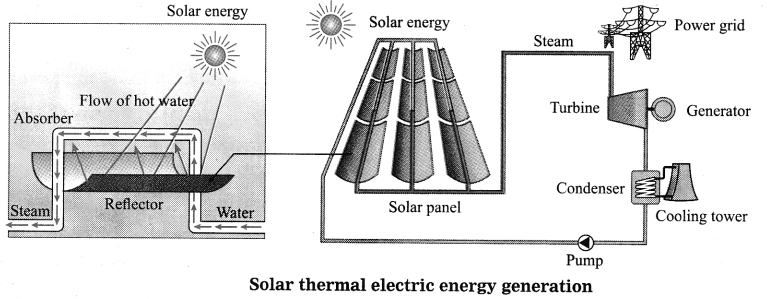
Question 13.
Give your opinion about whether hydroelectric plants are environment-friendly or not?
Answer:

Question 14.
Draw a neat labelled diagrams.
a. Energy transformation in solar thermal electric energy generation.
Answer:
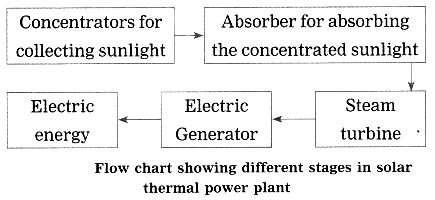
b. One solar panel produces a potential difference of 18 V and current of 3A. Describe how you can obtain a potential difference of 72 Volts and current of 9 A with a solar array using solar panels. You can use sign of a battery for a solar panel.
Answer:
Given Potential difference is 18 V and current is 3A. The requirement is potential difference of 72 V and current is 9A Voltage remains the same if connected in parallel and gets added it they are connected in series. Current remains the same if connected in series but adds if connected in parallel.
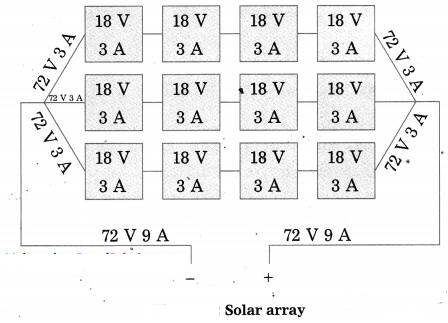
Question 15.
Write a short note on Electrical energy generation and environment.
Answer:
The energy obtained through the fossil fuels as well as nuclear energy can cause degradation of the environment. If such energy sources are used, they can cause harm to the environment.
(1) The burning of fossil fuels cause air pollution. The incomplete combustion of fossil fuels cause release of carbon monoxide. Some more toxic gases and soot particles cause various respiratory diseases. The carbon dioxide produced is creating global warming and climate change. The nitrogen dioxide released through burning is responsible for acid rains.
(2) Fossil fuels are limited. They are getting fast depleted. It has taken millions of years for the fossil fuels to form. The exploration of such fuels also cause environmental degradation and marine pollution too.
(3) In production of nuclear energy, there is a great risk of accidents. The safe disposal of nuclear waste is also a problem.
(4) Hydroelectric power from water reservoirs, wind power from wind, solar energy from sun and electricity from biofuels are eco-friendly alternatives.
Projects: (Do it your self)
Project 1.
Gather information about solar light, solar water heating system and solar cooker.
Project2.
Gather information about a power plant near your locality by visiting the plant.

Can you recall? (Text Book Page No. 47)
Question 1.
What is Energy?
Answer:
The capacity to do work is called energy.
Question 2.
What are different types of Energy?
Answer:
Potential energy and kinetic energy are the two types of energy.
Question 3.
What are different forms of Energy?
Answer:
Heat, light, electric energy, solar energy, chemical energy, nuclear energy, mechanical energy, etc. are different forms of energy.
Use your brain power! (Text Book Page No. 54)
Question 1.
The schematic of hydroelectric plant is shown in Figure 5.17 on text book page no. 54. Water from about middle of the total height of the dam is taken to the turbine, as shown by point B in the diagram.
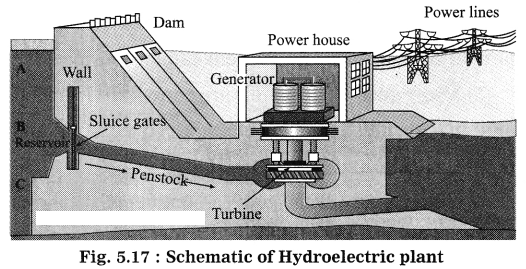
(i) With reference to point B, potential energy of how much water reservoir in the dam will be converted into kinetic energy?
Answer:
When the sluice gate at point B is opened, the water from reservoir will start flowing. The potential energy of the stored water will become kinetic energy of the quantity of water that is let out through the sluice gates.
(ii) What will be the effect on electricity generation, if the channel taking water to turbine starts at point A?
Answer:
If the channel taking water to turbine starts at point A, then the water will flow with a greater speed. Since point A is at hSight, water will acquire speed. This will result into more efficient rotation of the blades of turbine. The electricity generation will thus become more efficient.
(iii) What will be the effect on electricity generation, if the channel taking water to turbine starts at point C?
Answer:
If the channel taking water to turbine starts at point C, it will affect the electricity generation adversely. Point C is on the lower height as compared to the channel that carries water to the turbine. The flow of the water thus will be affected resulting into improper rotation of blades of turbine. This will certainly affect the electricity generation.
Choose the correct alternative and write its alphabet against the sub-question number:
Question 1.
Large ……….. are used in commercial power generation plants.
(a) machines
(b) generators
(c) turbines
(d) pannels
Answer:
(b) generators
Question 2.
The principle of electromagnetic ……….. was invented by Michael Faraday.
(a) induction
(b) attraction
(c) repulsion
(d) expulsion
Answer:
(a) induction
Question 3.
………… is used to rotate the magnet in the generator.
(a) fan
(b) Generator
(c) Turbine
(d) Panels
Answer:
(c) Turbine
Question 4.
In thermal power plants, the ………… energy in the coal is converted into electrical energy through several steps.
(a) physical
(b) biological
(c) kinetic
(d) chemical
Answer:
(d) chemical
Question 5.
At ………. in Andhra Pradesh power plant based on natural gas has been installed.
(a) Hyderabad
(b) Vishakhapatnam
(c) Samaralkota
(d) Kakinada
Answer:
(c) Samaralkota
Question 6.
Burning of coal may cause serious health problems related to ……….. system.
(a) digestive
(b) respiratory
(c) nervous
(d) excretory
Answer:
(b) respiratory

Question 7.
Incomplete combustion of fuels leads to formation of ……….
(a) carbon dioxide
(b) carbon monoxide
(c) carbon tetrachloride
(d) All the above
Answer:
(b) carbon monoxide
Question 8.
Solar cells are made of a special type of material called semiconductor such as ………..
(a) silicon
(b) uranium
(c) borosilicate
(d) hydrogen
Answer:
(a) silicon
Question 9.
……….. of the following is eco-friendly energy resource. (Board’s Model Activity Sheet)
(a) Coal
(b) Hydroelectric power
(c) Fossil fuel
(d) Atomic energy
Answer:
(b) Hydroelectric power
Question 10.
Which is the most abundant and renewable energy?
(a) Thermal power
(b) Solar energy
(c) Fossil fuels
(d) Atomic power
Answer:
(b) Solar energy
Question 11.
What are the two technologies for harnessing solar energy?
(a) Solar photovoltaics and solar thermal
(b) Solar cooker and solar lamp
(c) Heat capturing and Heat conversation
(d) Active and passive technologies
Answer:
(a) Solar photovoltaics and solar thermal
Question 12.
Which of the following is used in solar cooker to harvest the solar energy?
(a) Solar panels
(b) Silicon cell
(c) Mirrors
(d) Glass lid
Answer:
(c) Mirrors
Question 13.
Which of the following is not the source of green energy?
(a) Wind
(b) Natural gas
(c) Sunlight
(d) Fossil fuel
Answer:
(d) Fossil fuel
Question 14.
The solar lamp uses the energy.
(a) Heat
(b) Wind
(c) Light
(d) Sound
Answer:
(c) Light
State whether the following statements are true or false with proper explanation:
Question 1.
In thermal power plants, the turbines work on solar energy.
Answer:
False. (In thermal power plant, the turbines work on steam. The turbines working on solar energy are not used.)
Question 2.
How to dispose the nuclear waste safely is a big challenge before the scientists.
Answer:
True. (Nuclear waste disposal is the greatest problem. It produces highly toxic effects in any ecosystem. Therefore, disposing such radioactive substances becomes a major challenge.)
Question 3.
The efficiency of power generation using coal plant is higher than that of power generation plant based on natural gas.
Answer:
False. (The efficiency of power generation using natural gas plant is higher than that of power generation plant based on coal.)
Question 4.
Energy obtained from nuclear fission is eco-friendly.
Answer:
False. (Energy obtained from nuclear fission is not eco-friendly, because if accidents happen it leads to hazardous accidents.)
Question 5.
In hydroelectric power plant, the kinetic energy in water stored in dam is converted into potential energy of water.
Answer:
False. (In hydroelectric power plant, the potential energy in water stored in dam is converted into kinetic energy of water. The forceful downpour of flowing water causes this kinetic energy.)

Question 6.
The turbine is connected to electric generator, therefore the magnet rotates and electric energy is thus produced.
Answer:
True. (The rotating wheels of turbine cause mechanical energy. This energy helps to produce electrical energy.)
Question 7.
Use of energy is unavoidable in our daily life, but we must use it carefully and only in the required amount.
Answer:
True. (The energy Supply for everyday use results into lot of pollution. This causes harmful effects in the surrounding environment. Therefore, energy should be used in minimal amount and with great care.)
Question 8.
The machine which converts the potential energy of wind to electrical energy is called wind-turbine.
Answer:
False. (When wind blows, the kinetic energy is present in it. This kinetic energy is converted into electricity. The flowing wind never has a potential energy.)
Question 9.
The potential difference available from a solar cell is independent of its area.
Answer:
True. (The potential difference available from a solar cell is independent of its area. However, it is dependent on the way in which solar cells are connected.)
Question 10.
The power available from the solar cells is AC.
Answer:
False. (The power available from solar cells is always DC while the domestic appliances that we use work on AC.)
Match the columns:
Question 1.
Answer:
(1) Polluting energy – Thermal energy
(2) Eco-friendly energy – Wind energy

Question 2.
Answer:
(1) Pollutants – Soot particles
(2) Hazard to ecosystem – Nuclear energy
Question 3.
Answer:
(1) Nuclear energy – Disposal of wastes
(2) Natural gas – Limited reserves
Question 4.
Answer:
(1) Solar energy – Rainy season and darkness
(2) Hydroelectric energy – Rehabilitation of displaced people
Find the odd one out:
Question 1.
Kudankulam, Tarapur, Ravatabhata, Anjanvel
Answer:
Anjanvel. (All others are places having nuclear power plants.)
Question 2.
Samaralkota, Kudankulam, Bavanaa, Kondapalli
Answer:
Kudankulam. (All others are places having power plants based on natural gas.)
Question 3.
Tehari, Koyana, Srishailam, Tarapur
Answer:
Tarapur. (All others are places having hydroelectric projects.)
Question 4.
Edible oil, crude oil, LPG, CNG
Answer:
Edible oil. (All others are fossil fuels.)
Question 5.
Hydroelectric energy, Solar energy, Nuclear energy, Wind energy
Answer:
Nuclear energy. (All others are eco-friendly green energy types.)

Explain with diagram step-by-step energy conversion in:
Question 1.
Power plant based on natural gas.
Answer:
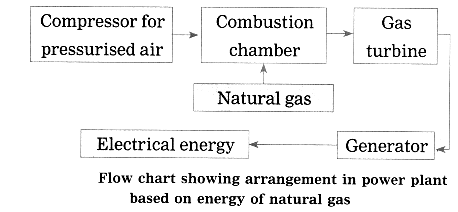
In a power plant based on natural gas, there are three main sections of the plant. There is combustion chamber with compressor in which the steam under pressure is introduced. The natural gas burns in the presence of air in this combustion chamber. This results in a production of a gas which is at very high temperature and pressure. This generated gas from the chamber runs the turbine. The kinetic energy of the turbine drives the generator. The generator produces electrical energy.
Question 2.
Power plant based on wind energy.
Answer:

Wind energy is used for moving turbines. The wind with specific speed is used to rotate the large fins of wind turbine. The kinetic energy in these fins is transferred to generator which then produces electrical energy.
Explain the following questions in detail:
Question 1.
What are the advantages of hydroelectric power generation? (March 2019)
Answer:
Question 2.
How is nuclear fission reaction carried out in nuclear power plants?
Answer:

Question 3.
Draw schematic of power plant based on natural gas and answer the following questions: (July 2019)
(a) At which place natural gas power plant is situated in Maharashtra?
(b) How is pollution reduced in natural gas based power plant?
(c) Give two examples of eco-friendly electricity process.
Answer:
(a) Natural gas power plant is situated at Anjanvel in Maharashtra.
(b) Natural gas does not contain sulfur. Burning of such natural gas does not produce pollution.
(c) Solar energy and wind energy are two examples of eco-friendly energy.
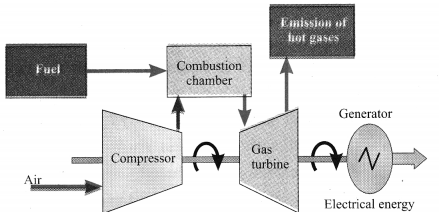
Complete the paragraph by choosing the appropriate words given in the brackets:
Question 1.
(marginal, array, cell, panel, string, current, power station, potential difference).
Many solar panels are connected in series and in parallel to generate required ………… and ……… Solar …………. is the basic unit in solar electric plant. Many solar cells come together to form a solar …………… Many solar panels connected in series form a solar ………., and many solar strings connected in parallel form a solar …………. As we can obtain as much electrical power as needed, they are used in applications which need ……….. power (e.g. calculators that run on solar energy) to ……….. of MW capacity.
Answer:
Many solar panels are connected in series and in parallel to generate required current and potential difference. Solar cell is the basic unit in solar electric plant. Many solar cells come together to form a solar panel. Many solar panels connected in series form a solar string, and many solar strings connected in parallel form a solar array. As we can obtain as much electrical power as needed, they are used in applications which need marginal power (e.g. calculators that run on solar energy) to power station of MW capacity.
Read the paragraph and answer the questions given below:
1. Renewable energy is, energy produced from sources that do not deplete or can be replenished within a human’s life time. The most common examples include wind, solar, geothermal, biorhass, and hydroelectric power. This is in contrast to non-renewable sources such as fossil fuels. Most renewable energy is derived directly or indirectly from the sun. Sunlight can be captured directly using solar technologies. The sun’s heat drives winds, whose energy is captured with turbines. Plants also rely on the sun to grow and their stored energy can be utilized for bioenergy. Not all renewable energy sources rely on the sun. For example, geothermal energy utilizes the Earth’s internal heat, tidal energy relies on the gravitational pull of the moon, and hydroelectric power relies on the flow of water.
Questions and Answers :
Question1.
What is renewable energy?
Answer:
Renewable energy is energy that is produced from sources which will not get exhausted within a human’s life time.
Question 2.
Give the examples of renewable energy.
Answer:
Wind, solar, geothermal, biomass and hydroelectric power are some examples of renewable energy.
Question 3.
Why will energy from fossil fuel be over soon?
Answer:
Fossil fuels are exhaustible in their amount. We have been using these extensively in the past 100 years and hence it may get over soon. It is a non-renewable resource.
Question 4.
Name the renewable sources of energy which are not dependent on sun. What are they dependent upon?
Answer:
Geothermal energy, tidal energy and hydroelectric power are renewable energy resources which are not dependent on sun. Geothermal energy utilizes the Earth’s internal heat, tidal energy relies on the gravitational pull of the moon, and hydropower relies on the flow of water.
Question 5.
Which type of energy do we mostly use in India?
Answer:
The most used energy resource is coal, i.e. fossil fuel based energy followed by hydroelectric energy.

2. Read the information given below and solve the questions based on it.
Electric energy is produced in various ways like hydroelectric, wind power, solar energy, bio-fuel, etc. These energy sources are inexhaustible, sustainable. Besides, it does not cause any environmental problem.
Questions and Answers:
Question 1.
Above information is about which type of energy?
Answer:
From the above information, we understand about green energy.
Question 2.
Whether the fossil fuel is an example of this energy?
Answer:
Fossil fuels are not green energy.
Question3.
Draw the flow chart of production of electric energy.
Answer:

Diagram based questions:
Question 1.
Observe the connections of cells shown in the following images.
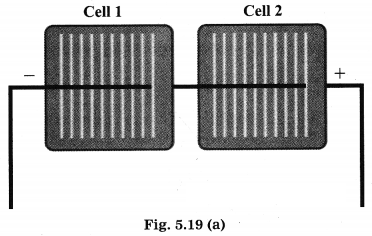
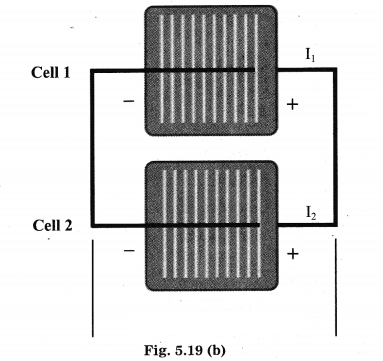
(i) Which connection will give maximum potential difference?
Answer:
The solar cells shown in the diagram 5.19 (a) are connected in series. This gives maximum potential difference.
(ii) Give one advantage and one disadvantage of this energy.
Answer:
Advantage of Solar energy: Solar energy is eco-friendly which does not create pollution. It is boundless source.
Disadvantage of solar energy: Solar energy is available only when sun is in the sky. Therefore, it has to be stored in batteries.
Question 2.
Answer the following questions:
(a) Write the name of the device shown in the above diagram.
Answer:
Steam turbine is the device shown in the above diagram.
(b) Write briefly the work of this device.
Answer:
Turbine is a device with the blades. When the flow of liquid or gases is directed on the blades of the turbine, they rotate. The rotation produces kinetic energy. This turbine is then used to rotate the magnet in the electric generator. For this purpose, turbines are connected with the generators. The magnets rotate and produce electric energy by electromagnetic induction. The turbines working on steam are used in large commercial power generation plants.

Question 3.
Label the given diagram of Electromagnetic induction.
Answer:
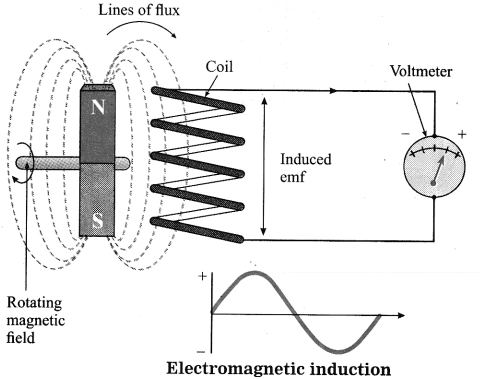
Question 4.
Answer the questions with the help of picture.
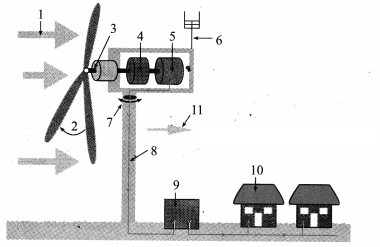
(a) Which type of energy is produced?
(b) This power plant is based on which energy source.
(c) Is this power plant eco-friendly? How?
Answer:
(a) In the picture, it is shown that using wind energy electricity is produced.
(b) The power plant shown here is based on kinetic energy of wind which is converted to electric energy by utilizing kinetic energy from rotating turbines.
(c) This power plant is eco-friendly because it does not cause pollution. Wind energy is green energy which is non-exhaustible and perpetual.
Question 5.
Observe the figure and answer the questions given below.
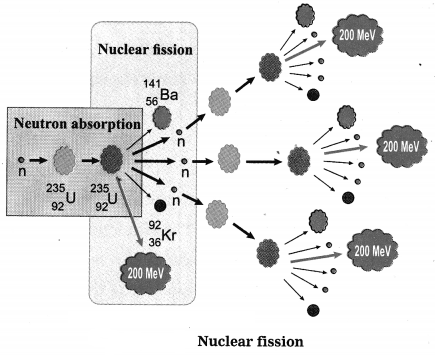
Answer:
(a) Name the reaction.
Answer:
The reaction shown in nuclear fission or chain reaction.
(b) Where is this reaction used?
Answer:
This reaction is used in nuclear power plants where electricity is generated.
(c) Which element is used in it?
Answer:
Uranium-235 is used in the nuclear fission reactions.
(OR)
Identify the process shown in figure and name it. (March 2019)
Answer:
The above figure shows nuclear fission chain reaction of Uranium – 236.

Question 6.
Observe the diagram and answer the questions : (March 2019)
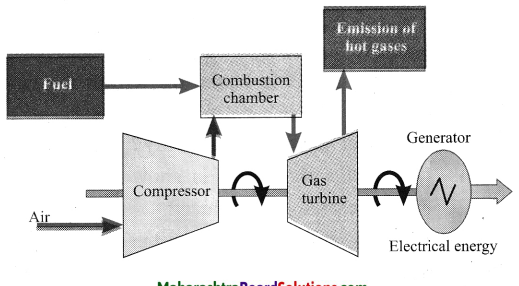
(a) Which energy is generated from the power plant?
Answer:
The diagram shows electricity generated from natural gas.
(b) State its source.
Answer:
The energy is generated from natural gas.
(c) Which is more eco-friendly – Power generation from coal or Power generation from natural gas? Why?
Answer:
Power generation from natural gas is more eco-friendly. Natural gas does not contain sulfur and hence its burning does not cause major pollution by forming sulphur dioxide. The efficiency of power generation by natural gas is also high.
Question 7.
Write the names of apparatus that is used in thermal power plant.
Answer:
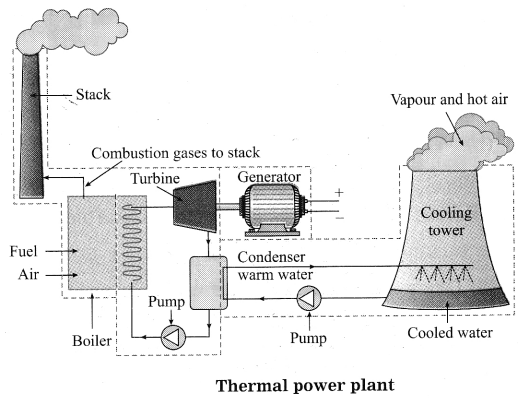
Question 8.
Label correctly the diagram of Nuclear power plant.
Answer:
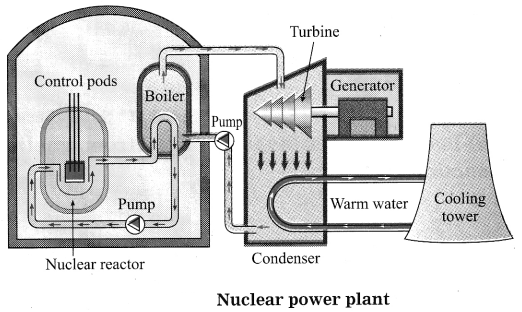
Question 9.
Label correctly the diagram of power plant baded on natural gas.
Answer:
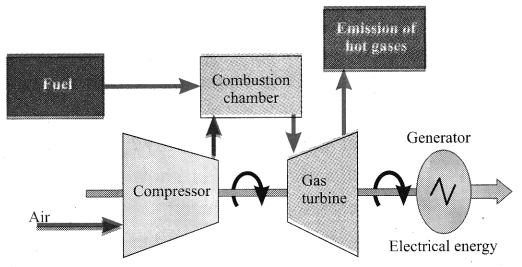
Question 10.
Label correctly the structures seen in Windmill.
Answer:
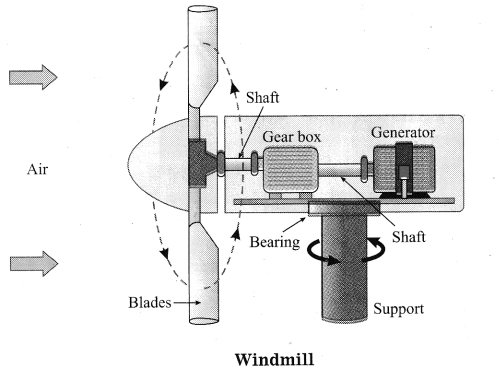

Question 11.
Sketch two ways in which solar cells can be connected. Also draw the diagrams to show the arrangement of solar cells to form solar? panel and solar array.
a. Solar cells in series.
Answer:
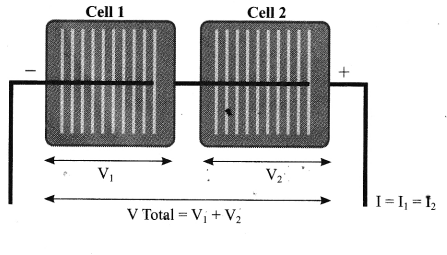
(b) Solar cells in parallel.
Answer:
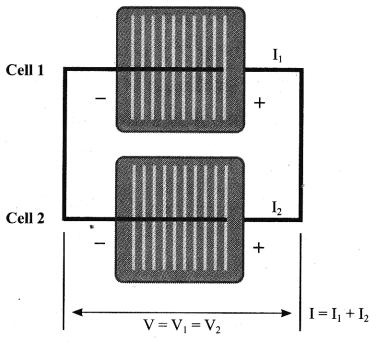
(c) Solar panel.
Answer:
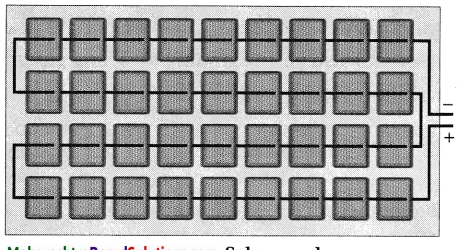
(d) Solar array.
Answer:
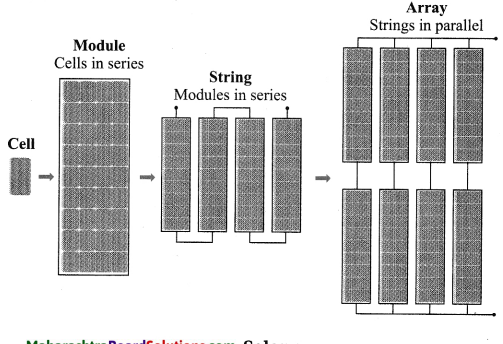
Question 12.
Observe the figure given below and answer the given questions:
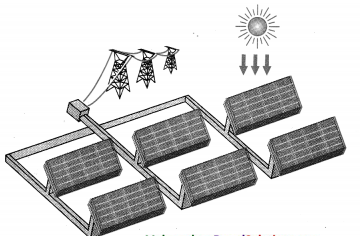
(a) Identify the type of energy generation process shown in this picture.
(b) Name any four equipments which use this type of energy. (Board’s Model Activity Sheet)
Answer:
(a) In this figure solar energy is converted into electrical energy. Solar energy is also called clean energy.
(b) Solar energy is used in following equipment:

Activity based questions.
Question 1.
Make a table: (Text Book Page No. 47)
Make a table based on forms of energy and corresponding devices.
Answer:
Question 2.
Let’s Think: (Text Book Page No. 52)
Which electricity generation process is eco-friendly and which not?
Answer:
Electricity generated through solar energy and wind energy are truly eco-friendly. Though it is said that hydroelectricity is non-polluting and eco-friendly, it is not true. Hydroelectric project cause destruction of biodiversity and displacement of the local people. Thermal energy, nuclear energy and energy obtained through natural gas are not at all eco-friendly.
Question 3.
Find out: (Text Book Page No. 55)
What is lake tapping? Why it takes place?
Answer:
A lake tap involves excavating a tunnel at the bottom of the lake. Dynamites are planted therein and blasted carefully. The water flows with greater force through the tunnel after such blasting is done. This increased flow of water is then driven to the hydroelectric power generation plant for increased electricity production. This technique is done to establish waterways for hydropower, for making drinking water available, for irrigation water purposes and also for the landing of oil and gas pipes from offshore fields.
Question 4.
Get information: (Text Book Page No. 56)
Get information about major wind-power stations in India and their capacity. Make a table of their location, state and their power generation capacity in MW.
Answer:
Question 5.
Find out: (Text Book Page No. 58)
Gather information about major solar photovoltaic power generating plants and their capacity in India.
Answer:
List of solar power stations:
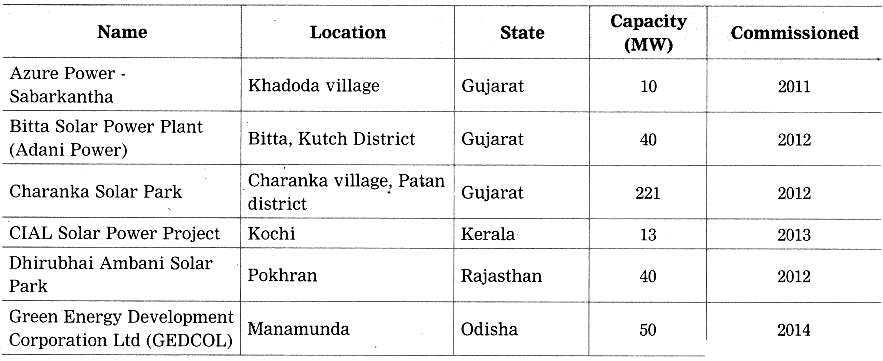
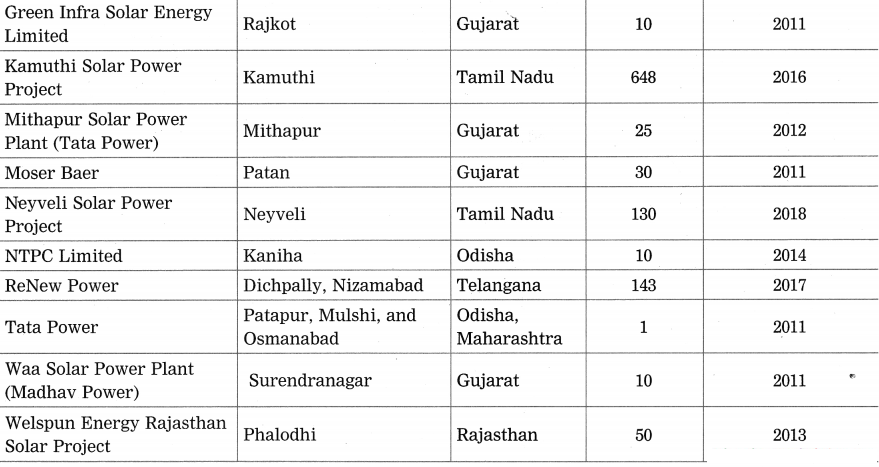

Project:
Project 1.
Let’s Discuss: (Text Book Page No. 47)
Make a list of the work that we do in our day-to-day life using energy. Which forms of energy do we use to do this work? Discuss with your friends.
Project 2.
Compare: (Text Book Page No. 51)
Observe the schematic of thermal power plant and the nuclear power plant. Discuss what are the similarities and differences between the two.
Project 3.
Use of ICT: (Text Book Page No. 49)
Prepare a presentation about thermal power plant using computerized presentation, animation, video, pictures, etc. Send it to others and upload on YouTube.
Project 4.
Internet is my friend: (Text Book Page No. 51)
Complete the following table for some important nuclear power plants in India.
Part 2 Chapter 5 Towards Green Energy Notes, Textbook Exercise Important Questions and Answers.
Question 1.
Remake the table taking into account relation between entries in three columns.
| I | II | III |
| Coal | Potential energy | Wind electricity plant |
| Uranium | Kinetic energy | Hydroelectric plant |
| Water reservoir | Nuclear energy | Thermal plant |
| Wind | Thermal energy | Nuclear power plant |
| I | II | III |
| Coal | Thermal energy | Thermal plant |
| Uranium | Nuclear energy | Nuclear power plant |
| Water reservoir | Potential energy | Hydroelectric plant |
| Wind | Kinetic energy | Wind electricity plant |

Question 2.
Which fuel is used in thermal power plant? what are the problems associated with this type of power generation?
Answer:
(1) The fuel used in the thermal power plant is coal. Coal contains chemical energy. Upon burning it releases heat energy. This heat is used for generation of electricity in the thermal power plants.
(2) Problems associated with power 8enerations by thermal power plant:
(a) Air pollution: Due to burning of coal, there is emission of carbon dioxide, carbon monoxide, sulphur dioxide and nitrogen dioxide gases. These are harmful and toxic to health.
(b) Soot particles emitted during combustion can cause severe respiratory problems such as asthma.
Question 3.
Other than thermnl power plant. which power plants use thermal energy for power generation? In what different ways is the thermal energy obtained?
Answer:
(1) The power plant based on natural gas and the nuclear power plants also used thermal energy for the power generation. Apart from these, solar energy is also used to produce heat and thereby create the power.
(2) In nuclear power plant, the energy is released by carrying out fission of nuclei of atoms like Uranium or Plutonium. This energy is used to generate the steam of high temperature and high pressure. The steam rotates the turbine. The kinetic energy in steam drives the turbine and turbine in turn drives the generator.
(3) The combustion of natural gas produces gas, which is used to run the turbine. This gas is under high pressure and high temperature. This is used to produce thermal energy.
(4) In solar thermal power plant, thermal energy is generated with the help of solar radiation. For this reflectors and absorbers are used for concentrating solar radiation and converting it into thermal energy.
Question 4.
Which type/types of power generation involve maximum number of steps of energy conversion? In which power generation is the number minimum?
Answer:
The steps of energy conversion are maximum in the thermal power generation. They are minimum in wind energy generation.
Question 5.

a. Maximum energy generation in India is done using …………… energy.
Answer:
Maximum energy generation in India is done using thermal energy.
b. ………. energy is a renewable source of energy.
Answer:
wind energy is a renewable source of energy.
c.Solar energy can be called ……. energy.
Answer:
Solar energy can be called clean energy.
d. ……. energy of wind is used in wind mills.
Answer:
kinetic energy of wind is used in wind mills.
e. ………. energy of water in darns is used for generation of electricity.
Answer:
Potential energy of water in darns is used for generation of electricity.

Question 6.
Explain the difference.
a. Conventional and Non-conventional Sources of energy.
Answer:
Conventional Sources of energy:
Non-conventional Sources of energy:
b. Thermal electricity generation and Solar thermal electricity generation.
Answer:
Thermal electricity generation:
Solar thermal electricity generation:
Question 7.
What is meant by green energy? Which energy sources can be called green energy sources and why? Give examples.
Answer:
(1) Green energy means eco-friendly form of energy which does not cause environmental problems and are non-exhaustible, perpetual and sustainable.
(2) These sources of energy do not produce toxic gases or other pollutants, therefore they are safe.
(3) Examples of green energy: (i) Hydroelectric energy (ii) Wind energy (iii) Solar energy (iv) Energy obtained biofuels.
Question 8.
Explain the following sentences.
a. Energy obtained from fossil fuels is not green energy.
Answer:
Fossil fuels like petrol, diesel or natural gas when burnt, emit toxic gases and soot particles. Thus, fossil fuels cause air pollution. Burning of fossil fuels cause increased levels of carbon dioxide, carbon monoxide and nitrogen dioxide. The increased carbon dioxide emission results in global warming. Nitrogen oxide results later in acid-rain. Soot particles generated through burning of fuels cause respiratory problems iike asthma.
Moreover, the fossil fuels are non-renewable and exhaustible fuels. They have to be explored from the
deeper layers of the earth causing lots of environmental problems. Green energy is sustainable, renewable and abundant. It never creates any environmental problems and is non-polluting. Thus, energy obtained from fossil fuels is not at all a green energy.
b. Saving energy is the need of the hour.
Answer:
In modern civilization, continuous energy supply is needed for the technology and development. The energy has become a basic need for man. Most of the energy used in India is obtained from thermal power plant. For this energy generation, various fuels are used. The coal and fossil fuels are limited. Due to over-exploitation, these reserves are getting fast depleted. Use of fossil fuels is also resulting in pollution and climate change.
Nuclear energy can be very hazardous. Lot of research is being done in the field of green energy, but the tremendous human population always is in need of more energy. Therefore, each and every person should save the energy, as saving energy is the need of the hour.

Question 9.
Answer the following questions.
a. How can we get the required amount of energy by connecting solar panels?
Answer:
b. What are the advantages and limitations of solar energy?
Answer:
I. Advantages:
II. Limitations:
Question 10.
Explain with diagram step-by-step energy conversion in
a. Thermal power plant.
Answer:

In thermal power plant the turbines are rotated using steam. Here the coal is burnt. The heat energy liberated from this burning is used to heat the water in the boiler. This water produces steam of very high temperature and pressure. The kinetic energy in the steam rotates the turbines. The rotation of turbines produces its own mechanical kinetic energy.
The generators connected to turbines produce electrical energy. The steam is condensed in a condenser and converted back into water. In this way in thermal power plant, thermal energy to kinetic energy, kinetic energy into mechanical energy and mechanical energy to electrical energy, are the conversions that take place.
b. Nuclear power plant.
Answer:

In nuclear power plant, the energy is releasdd by fission of nuclei of atbms like Uranium or Plutonium. This energy is used to generate the steam or high temperature ind high pressure. The kinetic energy in the steam rotates the turbine. The turbine in turn drives the generator to produce electricity.
c. Solar thermal power plant.
Answer:

Solar radiation is used to produce thermal energy. For this purpose, many reflectors are used which concentrate the solar radiation on absorbers. The heat energy created due to solar radiations is used to make steam. The steam possesses kinetic energy. This kinetic energy drives turbine and generator. The electrical energy is thus created from this kinetic energy.
d. Hydroelectric power plant:
Answer:

In hydroelectric plant the water stored in the reservoir is used as a source or potential energy. This water is made to fall at a great speed and hence there is production of kinetic energy in flowing water. This fast flowing water ralling down from the reservoir is brought to the turbine at the lower levels. The kinetic energy of the flowing water in turn drives the turbine, The turbine then drives the generator and electrical energy is produced.

Question 11.
Give scientific reasons:
a. The construction of turbine is different for different types of power plants.
Answer:
b. It is absolutely necessary to control the fission reaction in nuclear power plants.
Answer:
c. Hydroelectric energy, solar energy and wind energy are called renewable energies. (July ’19, Board’s Model Activity Sheet)
Answer:
d. It is possible to produce energy from mW to MW using solar photovoltaic cells.
Answer:
Question 12.
Draw a Schematic diagram of Solar thermal electric energy generation.
Answer:

Question 13.
Give your opinion about whether hydroelectric plants are environment-friendly or not?
Answer:

Question 14.
Draw a neat labelled diagrams.
a. Energy transformation in solar thermal electric energy generation.
Answer:

b. One solar panel produces a potential difference of 18 V and current of 3A. Describe how you can obtain a potential difference of 72 Volts and current of 9 A with a solar array using solar panels. You can use sign of a battery for a solar panel.
Answer:
Given Potential difference is 18 V and current is 3A. The requirement is potential difference of 72 V and current is 9A Voltage remains the same if connected in parallel and gets added it they are connected in series. Current remains the same if connected in series but adds if connected in parallel.

Question 15.
Write a short note on Electrical energy generation and environment.
Answer:
The energy obtained through the fossil fuels as well as nuclear energy can cause degradation of the environment. If such energy sources are used, they can cause harm to the environment.
(1) The burning of fossil fuels cause air pollution. The incomplete combustion of fossil fuels cause release of carbon monoxide. Some more toxic gases and soot particles cause various respiratory diseases. The carbon dioxide produced is creating global warming and climate change. The nitrogen dioxide released through burning is responsible for acid rains.
(2) Fossil fuels are limited. They are getting fast depleted. It has taken millions of years for the fossil fuels to form. The exploration of such fuels also cause environmental degradation and marine pollution too.
(3) In production of nuclear energy, there is a great risk of accidents. The safe disposal of nuclear waste is also a problem.
(4) Hydroelectric power from water reservoirs, wind power from wind, solar energy from sun and electricity from biofuels are eco-friendly alternatives.
Projects: (Do it your self)
Project 1.
Gather information about solar light, solar water heating system and solar cooker.
Project2.
Gather information about a power plant near your locality by visiting the plant.

Can you recall? (Text Book Page No. 47)
Question 1.
What is Energy?
Answer:
The capacity to do work is called energy.
Question 2.
What are different types of Energy?
Answer:
Potential energy and kinetic energy are the two types of energy.
Question 3.
What are different forms of Energy?
Answer:
Heat, light, electric energy, solar energy, chemical energy, nuclear energy, mechanical energy, etc. are different forms of energy.
Use your brain power! (Text Book Page No. 54)
Question 1.
The schematic of hydroelectric plant is shown in Figure 5.17 on text book page no. 54. Water from about middle of the total height of the dam is taken to the turbine, as shown by point B in the diagram.

(i) With reference to point B, potential energy of how much water reservoir in the dam will be converted into kinetic energy?
Answer:
When the sluice gate at point B is opened, the water from reservoir will start flowing. The potential energy of the stored water will become kinetic energy of the quantity of water that is let out through the sluice gates.
(ii) What will be the effect on electricity generation, if the channel taking water to turbine starts at point A?
Answer:
If the channel taking water to turbine starts at point A, then the water will flow with a greater speed. Since point A is at hSight, water will acquire speed. This will result into more efficient rotation of the blades of turbine. The electricity generation will thus become more efficient.
(iii) What will be the effect on electricity generation, if the channel taking water to turbine starts at point C?
Answer:
If the channel taking water to turbine starts at point C, it will affect the electricity generation adversely. Point C is on the lower height as compared to the channel that carries water to the turbine. The flow of the water thus will be affected resulting into improper rotation of blades of turbine. This will certainly affect the electricity generation.
Choose the correct alternative and write its alphabet against the sub-question number:
Question 1.
Large ……….. are used in commercial power generation plants.
(a) machines
(b) generators
(c) turbines
(d) pannels
Answer:
(b) generators
Question 2.
The principle of electromagnetic ……….. was invented by Michael Faraday.
(a) induction
(b) attraction
(c) repulsion
(d) expulsion
Answer:
(a) induction
Question 3.
………… is used to rotate the magnet in the generator.
(a) fan
(b) Generator
(c) Turbine
(d) Panels
Answer:
(c) Turbine
Question 4.
In thermal power plants, the ………… energy in the coal is converted into electrical energy through several steps.
(a) physical
(b) biological
(c) kinetic
(d) chemical
Answer:
(d) chemical
Question 5.
At ………. in Andhra Pradesh power plant based on natural gas has been installed.
(a) Hyderabad
(b) Vishakhapatnam
(c) Samaralkota
(d) Kakinada
Answer:
(c) Samaralkota
Question 6.
Burning of coal may cause serious health problems related to ……….. system.
(a) digestive
(b) respiratory
(c) nervous
(d) excretory
Answer:
(b) respiratory

Question 7.
Incomplete combustion of fuels leads to formation of ……….
(a) carbon dioxide
(b) carbon monoxide
(c) carbon tetrachloride
(d) All the above
Answer:
(b) carbon monoxide
Question 8.
Solar cells are made of a special type of material called semiconductor such as ………..
(a) silicon
(b) uranium
(c) borosilicate
(d) hydrogen
Answer:
(a) silicon
Question 9.
……….. of the following is eco-friendly energy resource. (Board’s Model Activity Sheet)
(a) Coal
(b) Hydroelectric power
(c) Fossil fuel
(d) Atomic energy
Answer:
(b) Hydroelectric power
Question 10.
Which is the most abundant and renewable energy?
(a) Thermal power
(b) Solar energy
(c) Fossil fuels
(d) Atomic power
Answer:
(b) Solar energy
Question 11.
What are the two technologies for harnessing solar energy?
(a) Solar photovoltaics and solar thermal
(b) Solar cooker and solar lamp
(c) Heat capturing and Heat conversation
(d) Active and passive technologies
Answer:
(a) Solar photovoltaics and solar thermal
Question 12.
Which of the following is used in solar cooker to harvest the solar energy?
(a) Solar panels
(b) Silicon cell
(c) Mirrors
(d) Glass lid
Answer:
(c) Mirrors
Question 13.
Which of the following is not the source of green energy?
(a) Wind
(b) Natural gas
(c) Sunlight
(d) Fossil fuel
Answer:
(d) Fossil fuel
Question 14.
The solar lamp uses the energy.
(a) Heat
(b) Wind
(c) Light
(d) Sound
Answer:
(c) Light
State whether the following statements are true or false with proper explanation:
Question 1.
In thermal power plants, the turbines work on solar energy.
Answer:
False. (In thermal power plant, the turbines work on steam. The turbines working on solar energy are not used.)
Question 2.
How to dispose the nuclear waste safely is a big challenge before the scientists.
Answer:
True. (Nuclear waste disposal is the greatest problem. It produces highly toxic effects in any ecosystem. Therefore, disposing such radioactive substances becomes a major challenge.)
Question 3.
The efficiency of power generation using coal plant is higher than that of power generation plant based on natural gas.
Answer:
False. (The efficiency of power generation using natural gas plant is higher than that of power generation plant based on coal.)
Question 4.
Energy obtained from nuclear fission is eco-friendly.
Answer:
False. (Energy obtained from nuclear fission is not eco-friendly, because if accidents happen it leads to hazardous accidents.)
Question 5.
In hydroelectric power plant, the kinetic energy in water stored in dam is converted into potential energy of water.
Answer:
False. (In hydroelectric power plant, the potential energy in water stored in dam is converted into kinetic energy of water. The forceful downpour of flowing water causes this kinetic energy.)

Question 6.
The turbine is connected to electric generator, therefore the magnet rotates and electric energy is thus produced.
Answer:
True. (The rotating wheels of turbine cause mechanical energy. This energy helps to produce electrical energy.)
Question 7.
Use of energy is unavoidable in our daily life, but we must use it carefully and only in the required amount.
Answer:
True. (The energy Supply for everyday use results into lot of pollution. This causes harmful effects in the surrounding environment. Therefore, energy should be used in minimal amount and with great care.)
Question 8.
The machine which converts the potential energy of wind to electrical energy is called wind-turbine.
Answer:
False. (When wind blows, the kinetic energy is present in it. This kinetic energy is converted into electricity. The flowing wind never has a potential energy.)
Question 9.
The potential difference available from a solar cell is independent of its area.
Answer:
True. (The potential difference available from a solar cell is independent of its area. However, it is dependent on the way in which solar cells are connected.)
Question 10.
The power available from the solar cells is AC.
Answer:
False. (The power available from solar cells is always DC while the domestic appliances that we use work on AC.)
Match the columns:
Question 1.
| Column I | Column II |
| (1) Polluting energy | (a) Soot particles |
| (2) Eco-friendly energy | (b) Thermal energy |
| (c) Nuclear energy | |
| (d) Wind energy |
(1) Polluting energy – Thermal energy
(2) Eco-friendly energy – Wind energy

Question 2.
| Column I | Column II |
| (1) Pollutants | (a) Soot particles |
| (2) Hazard to ecosystem | (b) Thermal energy |
| (c) Nuclear energy | |
| (d) Wind energy |
(1) Pollutants – Soot particles
(2) Hazard to ecosystem – Nuclear energy
Question 3.
| Type of energy | Problem |
| (1) Nuclear energy | (a) Rehabilitation of displaced people |
| (2) Natural gas | (b) Rainy season and darkness |
| (c) Limited reserves | |
| (d) Disposal of wastes |
(1) Nuclear energy – Disposal of wastes
(2) Natural gas – Limited reserves
Question 4.
| Type of energy | Problem |
| (1) Solar energy | (a) Rehabilitation of displaced people |
| (2) Hydroelectric energy | (b) Rainy season and darkness |
| (c) Limited reserves | |
| (d) Disposal of wastes |
(1) Solar energy – Rainy season and darkness
(2) Hydroelectric energy – Rehabilitation of displaced people
Find the odd one out:
Question 1.
Kudankulam, Tarapur, Ravatabhata, Anjanvel
Answer:
Anjanvel. (All others are places having nuclear power plants.)
Question 2.
Samaralkota, Kudankulam, Bavanaa, Kondapalli
Answer:
Kudankulam. (All others are places having power plants based on natural gas.)
Question 3.
Tehari, Koyana, Srishailam, Tarapur
Answer:
Tarapur. (All others are places having hydroelectric projects.)
Question 4.
Edible oil, crude oil, LPG, CNG
Answer:
Edible oil. (All others are fossil fuels.)
Question 5.
Hydroelectric energy, Solar energy, Nuclear energy, Wind energy
Answer:
Nuclear energy. (All others are eco-friendly green energy types.)

Explain with diagram step-by-step energy conversion in:
Question 1.
Power plant based on natural gas.
Answer:

In a power plant based on natural gas, there are three main sections of the plant. There is combustion chamber with compressor in which the steam under pressure is introduced. The natural gas burns in the presence of air in this combustion chamber. This results in a production of a gas which is at very high temperature and pressure. This generated gas from the chamber runs the turbine. The kinetic energy of the turbine drives the generator. The generator produces electrical energy.
Question 2.
Power plant based on wind energy.
Answer:

Wind energy is used for moving turbines. The wind with specific speed is used to rotate the large fins of wind turbine. The kinetic energy in these fins is transferred to generator which then produces electrical energy.
Explain the following questions in detail:
Question 1.
What are the advantages of hydroelectric power generation? (March 2019)
Answer:
Question 2.
How is nuclear fission reaction carried out in nuclear power plants?
Answer:

Question 3.
Draw schematic of power plant based on natural gas and answer the following questions: (July 2019)
(a) At which place natural gas power plant is situated in Maharashtra?
(b) How is pollution reduced in natural gas based power plant?
(c) Give two examples of eco-friendly electricity process.
Answer:
(a) Natural gas power plant is situated at Anjanvel in Maharashtra.
(b) Natural gas does not contain sulfur. Burning of such natural gas does not produce pollution.
(c) Solar energy and wind energy are two examples of eco-friendly energy.

Complete the paragraph by choosing the appropriate words given in the brackets:
Question 1.
(marginal, array, cell, panel, string, current, power station, potential difference).
Many solar panels are connected in series and in parallel to generate required ………… and ……… Solar …………. is the basic unit in solar electric plant. Many solar cells come together to form a solar …………… Many solar panels connected in series form a solar ………., and many solar strings connected in parallel form a solar …………. As we can obtain as much electrical power as needed, they are used in applications which need ……….. power (e.g. calculators that run on solar energy) to ……….. of MW capacity.
Answer:
Many solar panels are connected in series and in parallel to generate required current and potential difference. Solar cell is the basic unit in solar electric plant. Many solar cells come together to form a solar panel. Many solar panels connected in series form a solar string, and many solar strings connected in parallel form a solar array. As we can obtain as much electrical power as needed, they are used in applications which need marginal power (e.g. calculators that run on solar energy) to power station of MW capacity.
Read the paragraph and answer the questions given below:
1. Renewable energy is, energy produced from sources that do not deplete or can be replenished within a human’s life time. The most common examples include wind, solar, geothermal, biorhass, and hydroelectric power. This is in contrast to non-renewable sources such as fossil fuels. Most renewable energy is derived directly or indirectly from the sun. Sunlight can be captured directly using solar technologies. The sun’s heat drives winds, whose energy is captured with turbines. Plants also rely on the sun to grow and their stored energy can be utilized for bioenergy. Not all renewable energy sources rely on the sun. For example, geothermal energy utilizes the Earth’s internal heat, tidal energy relies on the gravitational pull of the moon, and hydroelectric power relies on the flow of water.
Questions and Answers :
Question1.
What is renewable energy?
Answer:
Renewable energy is energy that is produced from sources which will not get exhausted within a human’s life time.
Question 2.
Give the examples of renewable energy.
Answer:
Wind, solar, geothermal, biomass and hydroelectric power are some examples of renewable energy.
Question 3.
Why will energy from fossil fuel be over soon?
Answer:
Fossil fuels are exhaustible in their amount. We have been using these extensively in the past 100 years and hence it may get over soon. It is a non-renewable resource.
Question 4.
Name the renewable sources of energy which are not dependent on sun. What are they dependent upon?
Answer:
Geothermal energy, tidal energy and hydroelectric power are renewable energy resources which are not dependent on sun. Geothermal energy utilizes the Earth’s internal heat, tidal energy relies on the gravitational pull of the moon, and hydropower relies on the flow of water.
Question 5.
Which type of energy do we mostly use in India?
Answer:
The most used energy resource is coal, i.e. fossil fuel based energy followed by hydroelectric energy.

2. Read the information given below and solve the questions based on it.
Electric energy is produced in various ways like hydroelectric, wind power, solar energy, bio-fuel, etc. These energy sources are inexhaustible, sustainable. Besides, it does not cause any environmental problem.
Questions and Answers:
Question 1.
Above information is about which type of energy?
Answer:
From the above information, we understand about green energy.
Question 2.
Whether the fossil fuel is an example of this energy?
Answer:
Fossil fuels are not green energy.
Question3.
Draw the flow chart of production of electric energy.
Answer:

Diagram based questions:
Question 1.
Observe the connections of cells shown in the following images.


(i) Which connection will give maximum potential difference?
Answer:
The solar cells shown in the diagram 5.19 (a) are connected in series. This gives maximum potential difference.
(ii) Give one advantage and one disadvantage of this energy.
Answer:
Advantage of Solar energy: Solar energy is eco-friendly which does not create pollution. It is boundless source.
Disadvantage of solar energy: Solar energy is available only when sun is in the sky. Therefore, it has to be stored in batteries.
Question 2.
Answer the following questions:
(a) Write the name of the device shown in the above diagram.
Answer:
Steam turbine is the device shown in the above diagram.
(b) Write briefly the work of this device.
Answer:
Turbine is a device with the blades. When the flow of liquid or gases is directed on the blades of the turbine, they rotate. The rotation produces kinetic energy. This turbine is then used to rotate the magnet in the electric generator. For this purpose, turbines are connected with the generators. The magnets rotate and produce electric energy by electromagnetic induction. The turbines working on steam are used in large commercial power generation plants.

Question 3.
Label the given diagram of Electromagnetic induction.
Answer:

Question 4.
Answer the questions with the help of picture.

(a) Which type of energy is produced?
(b) This power plant is based on which energy source.
(c) Is this power plant eco-friendly? How?
Answer:
(a) In the picture, it is shown that using wind energy electricity is produced.
(b) The power plant shown here is based on kinetic energy of wind which is converted to electric energy by utilizing kinetic energy from rotating turbines.
(c) This power plant is eco-friendly because it does not cause pollution. Wind energy is green energy which is non-exhaustible and perpetual.
Question 5.
Observe the figure and answer the questions given below.

Answer:
(a) Name the reaction.
Answer:
The reaction shown in nuclear fission or chain reaction.
(b) Where is this reaction used?
Answer:
This reaction is used in nuclear power plants where electricity is generated.
(c) Which element is used in it?
Answer:
Uranium-235 is used in the nuclear fission reactions.
(OR)
Identify the process shown in figure and name it. (March 2019)
Answer:
The above figure shows nuclear fission chain reaction of Uranium – 236.

Question 6.
Observe the diagram and answer the questions : (March 2019)

(a) Which energy is generated from the power plant?
Answer:
The diagram shows electricity generated from natural gas.
(b) State its source.
Answer:
The energy is generated from natural gas.
(c) Which is more eco-friendly – Power generation from coal or Power generation from natural gas? Why?
Answer:
Power generation from natural gas is more eco-friendly. Natural gas does not contain sulfur and hence its burning does not cause major pollution by forming sulphur dioxide. The efficiency of power generation by natural gas is also high.
Question 7.
Write the names of apparatus that is used in thermal power plant.
Answer:

Question 8.
Label correctly the diagram of Nuclear power plant.
Answer:

Question 9.
Label correctly the diagram of power plant baded on natural gas.
Answer:

Question 10.
Label correctly the structures seen in Windmill.
Answer:


Question 11.
Sketch two ways in which solar cells can be connected. Also draw the diagrams to show the arrangement of solar cells to form solar? panel and solar array.
a. Solar cells in series.
Answer:

(b) Solar cells in parallel.
Answer:

(c) Solar panel.
Answer:

(d) Solar array.
Answer:

Question 12.
Observe the figure given below and answer the given questions:

(a) Identify the type of energy generation process shown in this picture.
(b) Name any four equipments which use this type of energy. (Board’s Model Activity Sheet)
Answer:
(a) In this figure solar energy is converted into electrical energy. Solar energy is also called clean energy.
(b) Solar energy is used in following equipment:

Activity based questions.
Question 1.
Make a table: (Text Book Page No. 47)
Make a table based on forms of energy and corresponding devices.
Answer:
| Forms of energy | Devices based on this type of energy |
| (1) Electric | Electric iron, Geyser, Heater, Oven, Refrigerator, Fans, Lights, Elevator. |
| (2) Mechanical | Sewing machine, Car, Bicycle, Different machines. |
| (3) Thermal | Chulha, Furnace, Steam engine |
| (4) Solar | Solar cooker, Solar heater. |
Let’s Think: (Text Book Page No. 52)
Which electricity generation process is eco-friendly and which not?
Answer:
Electricity generated through solar energy and wind energy are truly eco-friendly. Though it is said that hydroelectricity is non-polluting and eco-friendly, it is not true. Hydroelectric project cause destruction of biodiversity and displacement of the local people. Thermal energy, nuclear energy and energy obtained through natural gas are not at all eco-friendly.
Question 3.
Find out: (Text Book Page No. 55)
What is lake tapping? Why it takes place?
Answer:
A lake tap involves excavating a tunnel at the bottom of the lake. Dynamites are planted therein and blasted carefully. The water flows with greater force through the tunnel after such blasting is done. This increased flow of water is then driven to the hydroelectric power generation plant for increased electricity production. This technique is done to establish waterways for hydropower, for making drinking water available, for irrigation water purposes and also for the landing of oil and gas pipes from offshore fields.
Question 4.
Get information: (Text Book Page No. 56)
Get information about major wind-power stations in India and their capacity. Make a table of their location, state and their power generation capacity in MW.
Answer:
| Location | State | Power generation capacity in MW |
| Muppandal, Kanyakumari | Tamil Nadu | 7,684.31 |
| Dhule, Satara, Sangli, Dhalgaon | Maharashtra | 4,664.08 |
| Bhuj | Gujarat | 4,227.31 |
| Dangiri Wind Farm Jaisalmer Wind Park | Rajasthan | 4,123.35 |
| Jogmatti BSES | Karnataka | 3,082.45 |
| Bhopal at Nagda Hills near Dewas | Madhya Pradesh | 2,288.60 |
| Tirumala hills | Andhra Pradesh | 1,866.35 |
| Telangana | 98.70 | |
| Kanjikode in Palakkad | Kerala | 43.50 |
| Others | 4.30 | |
| Total | 28, 082.95 |
Find out: (Text Book Page No. 58)
Gather information about major solar photovoltaic power generating plants and their capacity in India.
Answer:
List of solar power stations:



Project:
Project 1.
Let’s Discuss: (Text Book Page No. 47)
Make a list of the work that we do in our day-to-day life using energy. Which forms of energy do we use to do this work? Discuss with your friends.
Project 2.
Compare: (Text Book Page No. 51)
Observe the schematic of thermal power plant and the nuclear power plant. Discuss what are the similarities and differences between the two.
Project 3.
Use of ICT: (Text Book Page No. 49)
Prepare a presentation about thermal power plant using computerized presentation, animation, video, pictures, etc. Send it to others and upload on YouTube.
Project 4.
Internet is my friend: (Text Book Page No. 51)
Complete the following table for some important nuclear power plants in India.